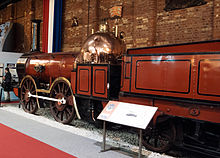| Furness Railway No.3 "Old Coppernob" | |||||||||||||||||||||
|---|---|---|---|---|---|---|---|---|---|---|---|---|---|---|---|---|---|---|---|---|---|
 No. 3 Old Coppernob, Furness Railway (1846–1899) No. 3 Old Coppernob, Furness Railway (1846–1899) | |||||||||||||||||||||
| |||||||||||||||||||||
| |||||||||||||||||||||
| |||||||||||||||||||||
| |||||||||||||||||||||
The Furness Railway No.3, nicknamed "Old Coppernob", is a preserved English steam locomotive. It acquired its nickname because of the copper cladding to its dome-shaped "haystack" firebox.
History
It was built in 1846 by Bury, Curtis, and Kennedy of Liverpool, a company with which the Furness Railway's first locomotive superintendent James Ramsden had been an apprentice. It is an 0-4-0 version of Edward Bury's popular bar-frame design of the period, with iron bar frames and inside cylinders, and is historically significant as the only survivor of this type in the United Kingdom. It is also one of the few preserved engines from the Furness Railway, whose Indian red livery it carries.
Withdrawal
It shared with three other similar engines all traffic on the Furness Railway for around six years. Latterly it was used for shunting around the docks at Barrow-in-Furness and on local duties, being withdrawn in 1900, completing nearly 55 years of service.
Preservation

It is now housed in the National Railway Museum, York. It has shrapnel wounds from German bombs, acquired during World War II when it was displayed in a glass pavilion at Barrow-in-Furness station.
In February 2007, No. 3 had one of its shedplates stolen at York. In 2014, it was placed on loan to the Dresden Transport Museum in Germany to take part in an exhibition celebrating the 175th anniversary of the Leipzig–Dresden railway due to its similarities to early locomotives built for the line.
See also
References
- Casserley, H.C. (1960). Historic locomotive pocket book. London: Batsford. pp. 10–11.
- "Cumberland and Westmorland Archives – Furness Railway". Cumberland and Westmorland Archives. Archived from the original on 5 October 2011. Retrieved 29 July 2011.
- "Furness Railway 'Coppernob' 0-4-0 steam locomotive, No 3, 1846". National Railway Museum.
- "Furness Railway No. 3 Locomotive Old Coppernob". Lindal & Marton Community Website.
- Lowe, James W. (1975). British Steam Locomotive Builders. Cambridge: Goose and Son. ISBN 0-900404-21-3.
- Rush, R. W. (1973). The Furness Railway, 1843–1923. Oakwood Press. ISBN 0-85361-117-3.
- Fancey, W. F. (1899). "An old locomotive". Railway Magazine. 4: 217–218.
- Verkehrsmuseum Dresden gGmH (Editor): Deutschland wird mobil. 175 Jahre Leipzig-Dresdner Eisenbahn. Dresden 2014. ISBN 978-3-936240-03-0, page 14-15.
Further reading
- Bailey, Michael R. (2014). "The Bury Type". Loco Motion. The History Press. pp. 136–138. ISBN 978-0-7524-9101-1.